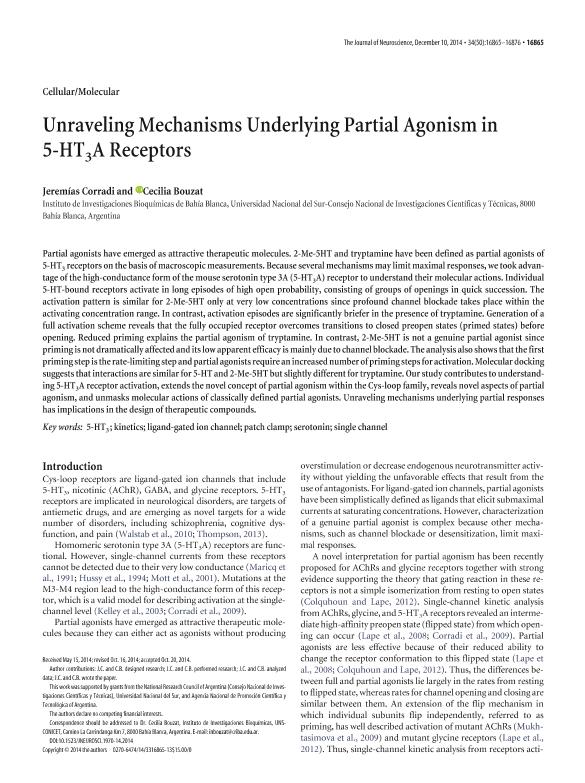Mostrar el registro sencillo del ítem
dc.contributor.author
Corradi, Jeremias

dc.contributor.author
Bouzat, Cecilia Beatriz

dc.date.available
2016-02-29T17:27:37Z
dc.date.issued
2014-12
dc.identifier.citation
Corradi, Jeremias; Bouzat, Cecilia Beatriz; Unraveling Mechanisms Underlying Partial Agonism in 5-HT3A receptors; Society For Neuroscience; Journal Of Neuroscience; 34; 50; 12-2014; 16865-16876
dc.identifier.issn
0270-6474
dc.identifier.uri
http://hdl.handle.net/11336/4507
dc.description.abstract
Partial agonists have emerged as attractive therapeutic molecules. 2-Me-5HT and tryptamine have been defined as partial agonists of 5-HT3 receptors on the basis of macroscopic measurements. Because several mechanisms may limit maximal responses we took advantage of the high-conductance form of the mouse 5-HT3A receptor to understand their molecular actions. Individual 5-HT-bound receptors activate in long episodes of high open probability, consisting of groups of openings in quick succession. The activation pattern is similar for 2-Me-5HT only at very low concentrations since profound channel blockade takes place within the activating concentration range. In contrast, activation episodes are significantly briefer in the presence of tryptamine. Generation of a full activation scheme reveals that the fully-occupied receptor overcomes transitions to closed pre-open states (primed states) before opening. Reduced priming explains the partial agonism of tryptamine. In contrast, 2-Me-5HT is not a genuine partial agonist since priming is not dramatically affected and its low apparent efficacy is mainly due to channel blockade. The analysis also shows that the first priming step is the rate-limiting step and partial agonists require an increased number of priming steps for activation. Molecular docking suggests that interactions are similar for 5-HT and 2-Me-5HT but slightly different for tryptamine. Our study contributes to understanding 5-HT3A receptor activation, extends the novel concept of partial agonism within the Cys-loop family, reveals novel aspects of partial agonism, and unmasks molecular actions of classically-defined partial agonists. Unraveling mechanisms underlying partial responses has implications in the design of therapeutic compounds.
dc.format
application/pdf
dc.language.iso
eng
dc.publisher
Society For Neuroscience

dc.rights
info:eu-repo/semantics/openAccess
dc.rights.uri
https://creativecommons.org/licenses/by-nc-nd/2.5/ar/
dc.subject
5-Ht3
dc.subject
Ligan-Gated Ion Channel
dc.subject
Sertonin
dc.subject
Patch-Clamp
dc.subject
Single Channel
dc.subject.classification
Biofísica

dc.subject.classification
Ciencias Biológicas

dc.subject.classification
CIENCIAS NATURALES Y EXACTAS

dc.title
Unraveling Mechanisms Underlying Partial Agonism in 5-HT3A receptors
dc.type
info:eu-repo/semantics/article
dc.type
info:ar-repo/semantics/artículo
dc.type
info:eu-repo/semantics/publishedVersion
dc.date.updated
2016-03-30 10:35:44.97925-03
dc.journal.volume
34
dc.journal.number
50
dc.journal.pagination
16865-16876
dc.journal.pais
Estados Unidos

dc.journal.ciudad
Washington
dc.description.fil
Fil: Corradi, Jeremias. Consejo Nacional de Investigaciones Científicas y Técnicas. Centro Científico Tecnológico CONICET Bahía Blanca. Instituto de Investigaciones Bioquímicas Bahía Blanca (i); Argentina. Universidad Nacional del Sur; Argentina
dc.description.fil
Fil: Bouzat, Cecilia Beatriz. Consejo Nacional de Investigaciones Científicas y Técnicas. Centro Científico Tecnológico CONICET Bahía Blanca. Instituto de Investigaciones Bioquímicas Bahía Blanca (i); Argentina. Universidad Nacional del Sur; Argentina
dc.journal.title
Journal Of Neuroscience

dc.relation.alternativeid
info:eu-repo/semantics/altIdentifier/doi/10.1523/JNEUROSCI.1970-14.2014
dc.relation.alternativeid
info:eu-repo/semantics/altIdentifier/doi/http://dx.doi.org/10.1523/JNEUROSCI.1970-14.2014
dc.relation.alternativeid
info:eu-repo/semantics/altIdentifier/url/http://www.ncbi.nlm.nih.gov/pubmed/25505338
dc.relation.alternativeid
info:eu-repo/semantics/altIdentifier/url/http://www.jneurosci.org/content/34/50/16865.long
Archivos asociados
